Diverse Scale Data for Shale Gas Formation Description—Why Is Digital Shale Rock Model Construction Difficult? The Polish Silurian and Ordovician Rocks Case Study
Abstract
1. Introduction
2. Geological Setting and Materials
3. Methods
4. Results
5. Conclusions
- Microresistivity curves form the modern tools, such as FMI and XRMI, together with a geochemical log (GEM or LithoScanner), are a source of detailed lithology information, reflecting changes of thickness of claystone and mudstone laminas in gas shales.
- Spectral gamma ray log SGR is a key log for the quick identification of shale formations sections rich in organic matter.
- Correlation of the organic matter OM vs. total pore volume V_tot (nitrogen adsorption/desorption at 77 K) was observed with the correlation coefficient R2 = 0.8, which demonstrated that the recorded parameters in the shale formation are mutually dependent and may be used to characterize the rock.
- MIP quantities illustrated the nanopores’ influence (up to 3 µm) on the porosity of the shale formations and broad pore-throat distribution.
- Adsorption/desorption of nitrogen at 77 K gave the information that a significant amount of gas, adsorbed at a low relative pressure, is indicative of microporosity. Moreover, only the density functional theory model (DFT) delivered the additional information about the microporosity in analyzed shale formations.
- Computed X-ray tomography showed that the samples differed in the number of pores and microfractures (by almost 6-fold), but almost 50% of the pores were concentrated in the volume range of 100–999 voxels. Feret coefficient correlated with the pressure decay permeability for the analyzed samples and can be associated with the quartz content in the sample.
- Diverse content of minerals (from the XRD analysis) caused the outlier position of the samples for the different correlations of laboratory measurement results.
Author Contributions
Acknowledgments
Conflicts of Interest
Abbreviation
| GR | gamma ray log, API |
| SGR | spectral gamma ray log |
| URAN, U | uranium content from the spectral gamma ray log, ppm |
| THOR | thorium content from the spectral gamma ray log, ppm |
| POTA | potassium content from the spectral gamma ray log, % |
| LLD | deep electric resistivity log from dual laterolog, ohmm |
| LLS | electric resistivity log from dual laterolog, ohmm |
| RHOB | bulk density RHOB, g/cc |
| PE | volumetric photoelectric absorption index, barn/electron |
| RHOMA | density of matrix, g/cc |
| DT | P wave slowness, µs/ft |
| NPHI | neutron porosity, ls (limestone porosity units) |
| Mg, Al, Si, K, Ca | results of the geochemical log GEM, as dry elemental weight percent, wt % |
| Illite, Fe-Chlorite, Plagioclase, Quartz, Dolomite, Calcite and Kerogen | the results of the volumetric percent of major and minor minerals from the geochemical log GEM, fraction |
| Free water, Gas, Clay water and Kerogen | volume of fluids and kerogen, fraction |
| SWT | total water saturation, fraction |
| SWE | effective water saturation, fraction |
| Por tot | total porosity, fraction |
| Por eff | effective porosity, fraction |
| XRMI | X-tended Micro Imager |
| TOC | total organic carbon, wt % |
References
- Kiersnowski, H. Geological Environment of Gas-Bearing Shales. In Shale Gas as Seen by Polish Geological Survey; Nawrocki, J., Ed.; Polish Geological Institute–National Research Institute: Warsaw, Poland, 2013; pp. 26–31. [Google Scholar]
- Poprawa, P. Shale gas potential of the Lower Paleozoic complex in the Baltic and Lublin-Podlasie basins (Poland). Geol. Rev. 2010, 58, 226–249. [Google Scholar]
- Jarzyna, J.; Wawrzyniak-Guz, K. Adaptation to the Polish Conditions of the Methodologies of the Sweet Spots Determination on the Basis of Correlation of Well Logging with Drilled Core Samples: Methodology to Determine Sweet Spots Based on Geochemical, Petrophysical and Geomechanical Properties in Connection with Correlation of Laboratory Test with Well Logs and Generation Model 3D; GOLDRUK Wojciech Golachowski Printing House: Nowy Sącz, Poland, 2017; 500p. [Google Scholar]
- Golonka, J.; Pietsch, K.; Barmuta, J.; Bębenek, S.; Botor, D.; Porębski, S.; Papiernik, B.; Barmuta, M.; Michna, M. Paleozoic evolution of the Eastern European Platform in Poland and shale gas potential. In Proceedings of the ACE2017 Annual Convention & Exibition 2017, 100 AAPG Anniversary, Houston, TX, USA, 2–5 April 2017. [Google Scholar]
- Cyz, M.; Malinowski, M. Seismic azimuthal anisotropy study of the Lower Paleozoic shale play in northern Poland. Interpretation 2018, 6, SH1–SH12. [Google Scholar] [CrossRef]
- Cyz, M.; Mulińska, M.; Pachytel, R.; Malinowski, M. Brittleness prediction for the Lower Paleozoic shales in northern Poland. Interpretation 2018, 6, SH13–SH23. [Google Scholar] [CrossRef]
- Więcław, D.; Kotarba, M.J.; Kosakowski, P.; Kowalski, A.; Grotek, I. Habitat and hydrocarbon potential of the lower Paleozoic source rocks in the Polish part of the Baltic region. Geol. Q. 2010, 54, 159–182. [Google Scholar]
- Porębski, S.J.; Prugar, W.; Zacharski, J. Silurian shales of the East European Platform in Poland—Some exploration problems. Geol. Rev. 2013, 61, 630–638. [Google Scholar]
- Podhalańska, T. Late Ordovician to Early Silurian transition and the graptolites from Ordovician/Silurian boundary near the SW rim of the East European Craton (northern Poland). Ser. Geol. Correl. 2003, 18, 165–172. [Google Scholar]
- Tomczyk, H. Stratigraphic problems of the Ordovician and Silurian in Poland in the light of recent studies. Pr. Państwowego Inst. Geol. 1962, 35, 1–134. [Google Scholar]
- Modliński, Z.; Szymański, B.; Teller, L. The Silurian lithostratigraphy of the Polish part of the Peri-Baltic Depression (N Poland). Geol. Rev. 2006, 54, 787–796. [Google Scholar]
- Modliński, Z.; Szymański, B. The Ordovician lithostratigraphy of the Peribaltic Depression (NE Poland). Geol. Q. 1997, 41, 273–288. [Google Scholar]
- Modliński, Z.; Szymański, B. Lithostratigraphy of the Ordovician in the Podlasie Depression and the basement of the Płock–Warsaw Trough (eastern Poland). Biul. Państwowego Inst. Geol. 2008, 430, 79–112. [Google Scholar]
- Washburn, E.W. The Dynamics of Capillary Flow. Phys. Rev. 1921, 17, 273–283. [Google Scholar] [CrossRef]
- Webb, P.A. An Introduction to the Physical Characterization of Materials by Mercury Intrusion Porosimetry with Emphasis on Reduction and Presentation of Experimental Data; Micrometrics Instruments Corp.: Norcross, Georgia, 2011. [Google Scholar]
- Thommes, M.; Kaneko, K.; Neimark, A.V.; Olivier, J.P.; Rodriguez–Reinoso, F.; Rouquerol, J.; Sing, K.S.W. Physisorption of gases. with special reference to the evaluation of surface area and pore size distribution (IUPAC Technical Report). Pure Appl. Chem. 2015, 87, 9–10, 1052–1069. [Google Scholar] [CrossRef]
- Rouquerol, F.; Rouquerol, J.; Sing, K.S.W.; Llewellyn, P.; Maurin, G. Adsorption by Powders and Porous Solids: Principles, Methodology and Applications; Academic Press: Cambridge, MA, USA, 2014. [Google Scholar]
- Gor, G.Y.; Thommes, M.; Cychosz, K.A.; Neimark, A.V. Quenched solid density functional theory method for characterization of mesoporous carbons by nitrogen adsorption. Carbon 2012, 50, 1583–1590. [Google Scholar] [CrossRef]
- Thommes, M. Physical Adsorption Characterization of Nanoporous Materials. Chem. Ing. Tech. 2010, 82, 1059–1073. [Google Scholar] [CrossRef]
- Donohue, M.D.; Aranovich, G.L. Classification of Gibbs adsorption isotherms. Adv. Colloid Interface Sci. 1998, 76–77, 137–152. [Google Scholar] [CrossRef]
- Jarzyna, J.A.; Czepirski, L.; Krakowska, P.I.; Puskarczyk, E.; Szczurowski, J. Petrophysical Model of Polish Shale Gas Rocks on the Basis of Various Laboratory Experiments. In Proceedings of the 79th EAGE Conference and Exhibition, EarthDoc, Paris, France, 12–15 June 2017. [Google Scholar] [CrossRef]
- Dudek, L. Pore size distribution in shale gas deposits based on adsorption isotherm analyses. Naft.-Gaz 2016, 8, 603–609. [Google Scholar] [CrossRef]
- Coates, G.R.; Xiao, L.; Prammer, M.G. NMR logging Principles & Applications; Halliburton Energy Service: Houston, TX, USA, 1999. [Google Scholar]
- Puskarczyk, E. Assessment of Reservoir Properties of Rock through Nuclear Magnetic Resonance Phenomenon Application. Ph.D. Thesis, AGH University of Science and Technology, Krakow, Poland, 2011. [Google Scholar]
- Terra Tek Schlumberger Reservoir Laboratory. TRA Glossary; Terra Tek Schlumberger Reservoir Laboratory: Houston, TX, USA, 2016. [Google Scholar]
- Jarzyna, J.A.; Krakowska, P.I.; Puskarczyk, E.; Wawrzyniak-Guz, K.; Bielecki, J.; Tkocz, K.; Tarasiuk, J.; Wroński, S.; Dohnalik, M. X-ray computed microtomography—A useful tool for petrophysical properties determination. Comput. Geosci. 2016, 20, 1155–1167. [Google Scholar] [CrossRef]
- Krakowska, P.I. Project Report: Innovative Method of Unconventional Oil and Gas Reservoirs Interpretation Using Computed X-ray Tomography; National Centre for Research and Development: Warsaw, Poland, 2019; unpublished. [Google Scholar]
- Krakowska, P.; Puskarczyk, E.; Jędrychowski, M.; Habrat, M.; Madejski, P.; Dohnalik, M. Innovative characterization of tight sandstones from Paleozoic basins in Poland using X-ray computed tomography supported by nuclear magnetic resonance and mercury porosimetry. J. Pet. Sci. Eng. 2018, 166, 389–405. [Google Scholar] [CrossRef]
- Madejski, P.; Krakowska, P.; Habrat, M.; Puskarczyk, E.; Jędrychowski, M. Comprehensive Approach for Porous Materials Analysis Using a Dedicated Preprocessing Tool for Mass and Heat Transfer Modeling. J. Therm. Sci. 2018, 27, 479–486. [Google Scholar]
- Topór, T.; Derkowski, A.; Kuila, U.; Fischer, T.B.; McCarty, D.K. Dual liquid porosimetry: A porosity measurement technique for oil-and gas-bearing shales. Fuel 2016, 183, 537–549. [Google Scholar] [CrossRef]
- Kuila, U.; McCarty, D.K.; Derkowski, A.; Fischer, T.B.; Prasad, M. Total porosity measurement in gas shales by the water immersion porosimetry (WIP) method. Fuel 2014, 117, 1115–1129. [Google Scholar] [CrossRef]
- Środoń, J.; Drits, V.A.; McCarty, D.K.; Hsieh, J.C.C.; Eberl, D.D. Quantitative XRD analysis of clay-rich rocks from random preparations. Clays Clay Miner. 2001, 49, 514–528. [Google Scholar] [CrossRef]
- Omotoso, O.; McCarty, D.K.; Hillier, S.; Kleeberg, R. Some successful approaches to quantitative mineral analysis as revealed by the 3rd Reynolds Cup contest. Clays Clay Miner. 2006, 54, 748–760. [Google Scholar] [CrossRef]
- Zorski, T.; Jarzyna, J.; Derkowski, A.; Środoń, J. Geofizyka otworowa w dobie poszukiwań gazu w łupkach–modele interpretacyjne i specyfika zastosowań w zagadnieniach rozpoznawania złóż gazu z łupków. Geol. Rev. 2013, 61, 478–488. (In Polish) [Google Scholar]
- Kotarba, M.J.; Lewan, M.; Więcław, D. Shale gas and oil potential of Lower Palaeozoic strata in the Polish Baltic Basin by Hydrous Pyrolysis. Presented at the Fourth EAGE Shale Workshop. Shales: What do they have in common? In Proceedings of the 4th EAGE Shale Workshop, Porto, Portugal, 6–9 April 2014. [Google Scholar]
- Curve Mnemonic Dictionary. Available online: www.slb.com (accessed on 25 January 2020).
- Wireline & Perforating, Formation Evaluation. Available online: www.halliburton.com (accessed on 25 January 2020).
- PGNiG SA. Halliburton GEM Mineralogical & Petrophysical Interpretation Summary; PGNiG SA: Warsaw, Poland, 2013. [Google Scholar]
- Rahmani, O.; Khoshnoodkia, M.; Kadkhodaie, A.; Pour, A.B.; Tsegab, H. Geochemical Analysis for Determining Total Organic Carbon Content Based on LogR Technique in the South Pars Field. Minerals 2019, 9, 735. [Google Scholar] [CrossRef]
- Liu, J.; Yao, Y.; Elsworth, D.; Liu, D.; Cai, Y.; Dong, L. Vertical Heterogeneity of the Shale Reservoir in the Lower Silurian Longmaxi Formation: Analogy between the Southeastern and Northeastern Sichuan Basin, SW China. Minerals 2017, 7, 151. [Google Scholar] [CrossRef]
- PoROSE Help. 2018. Available online: www.porose.pl (accessed on 25 January 2020).
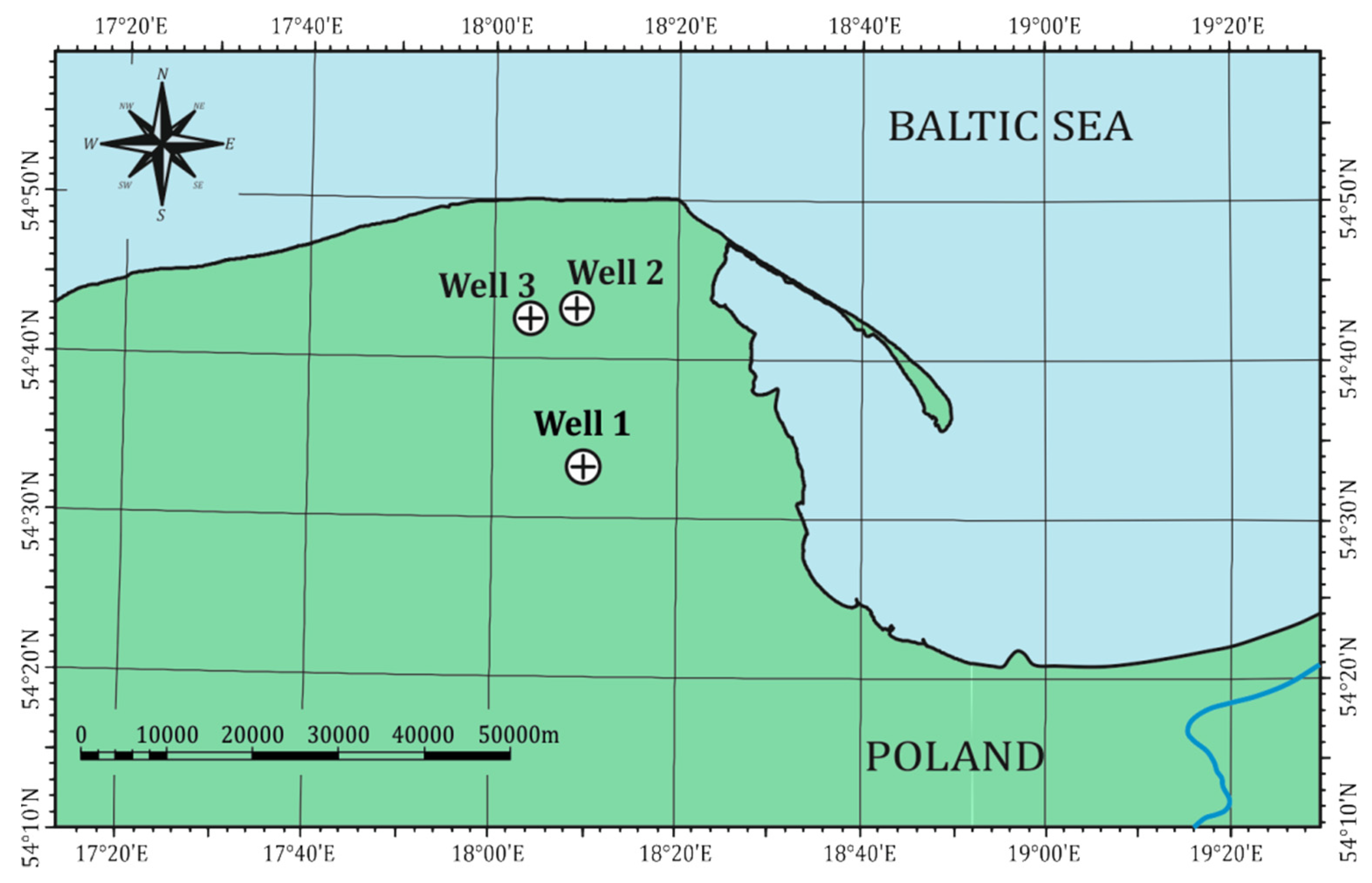
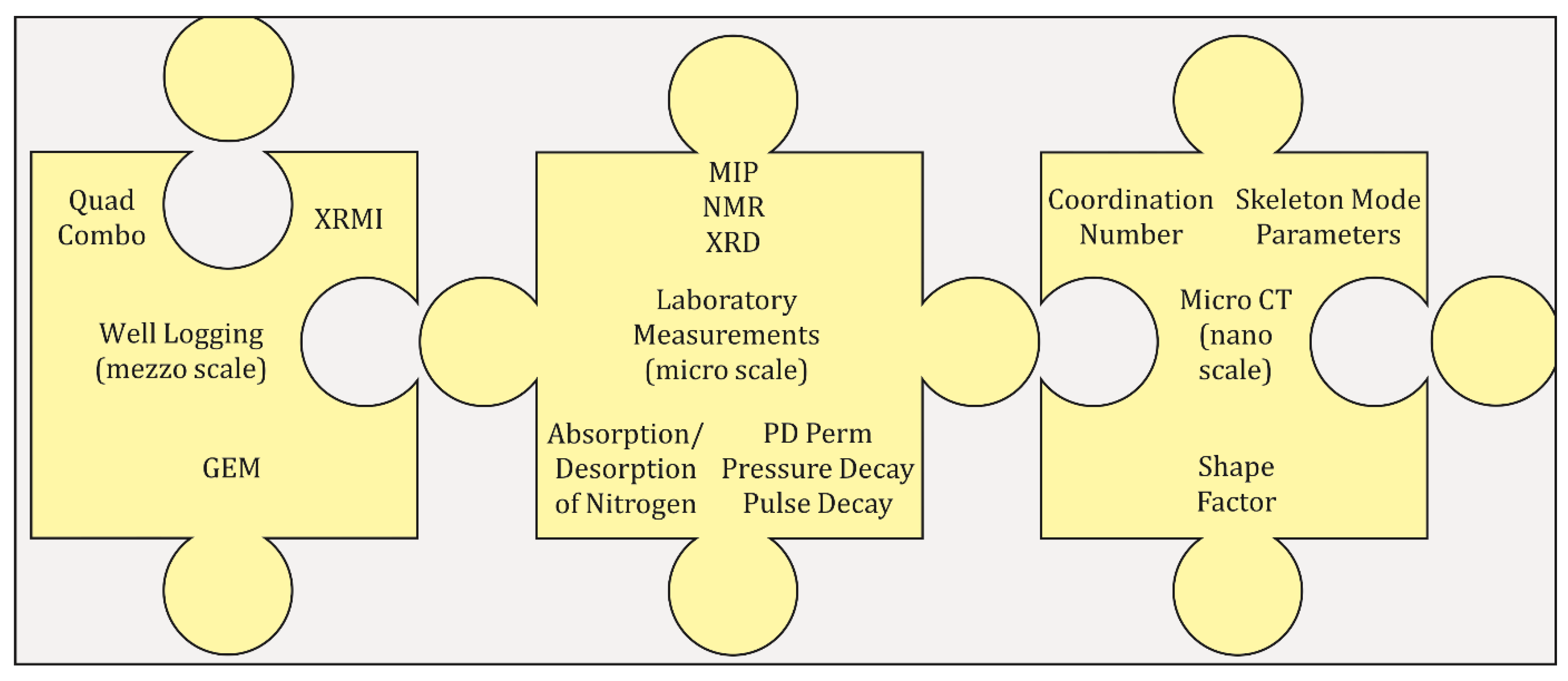
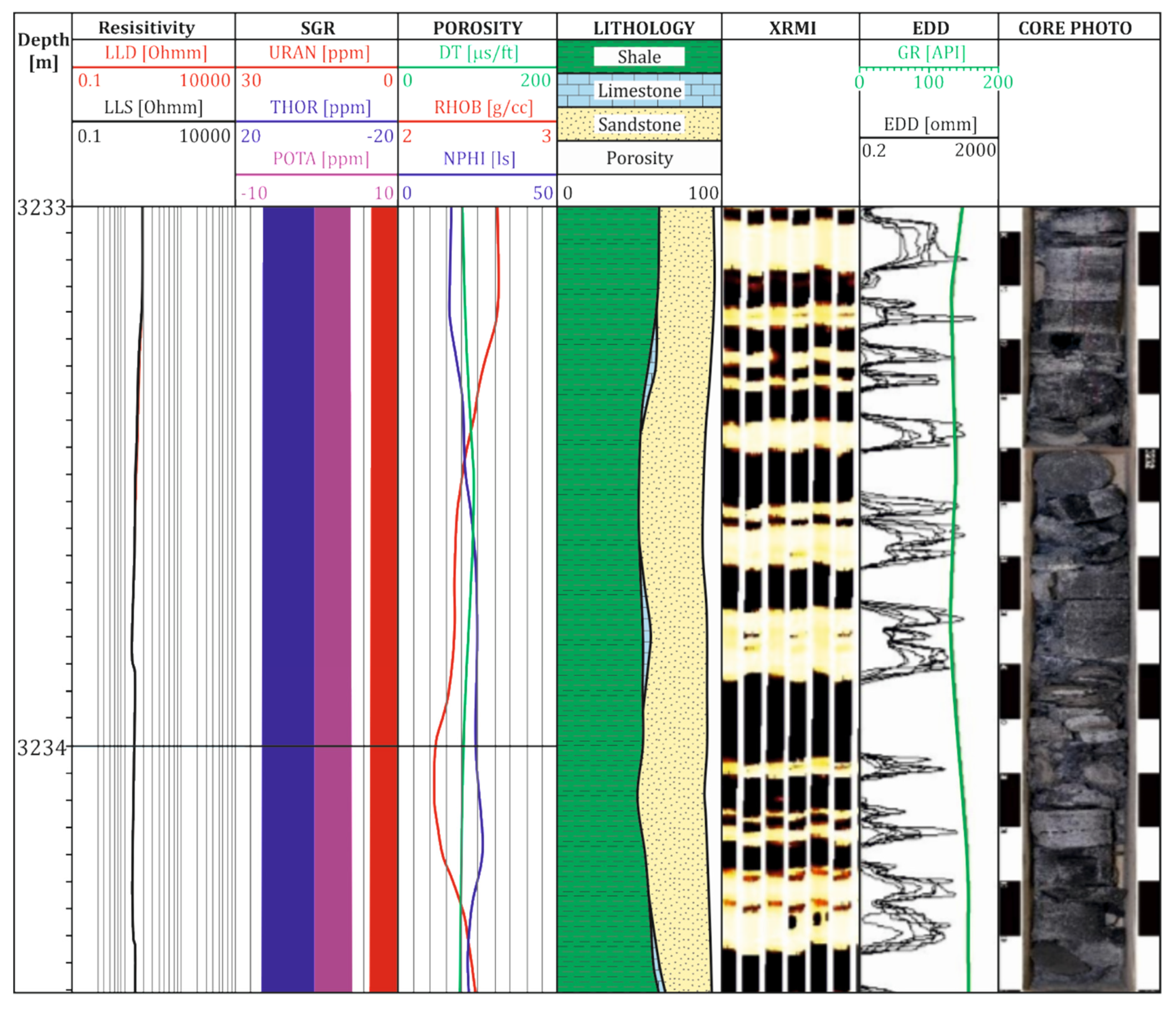
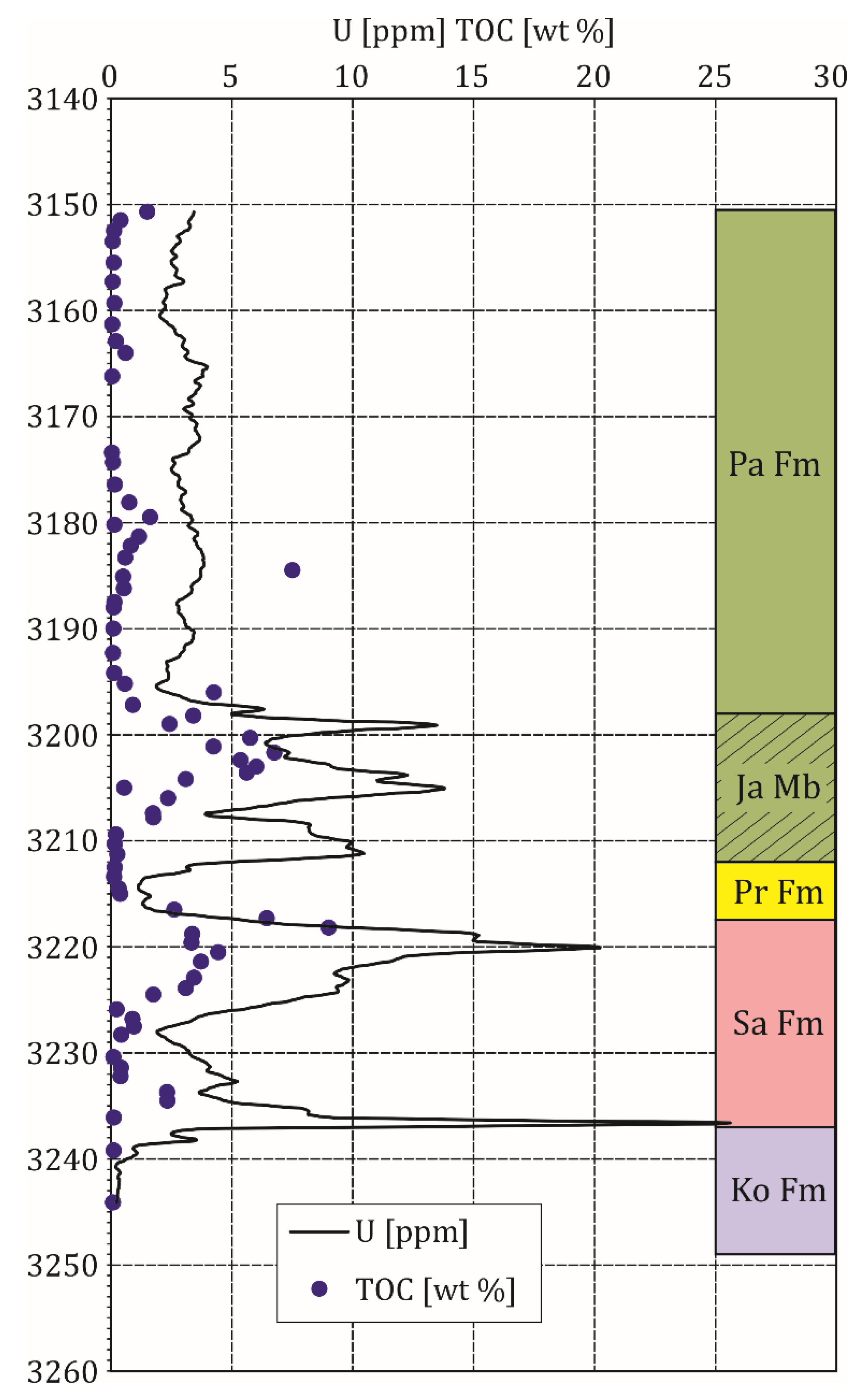
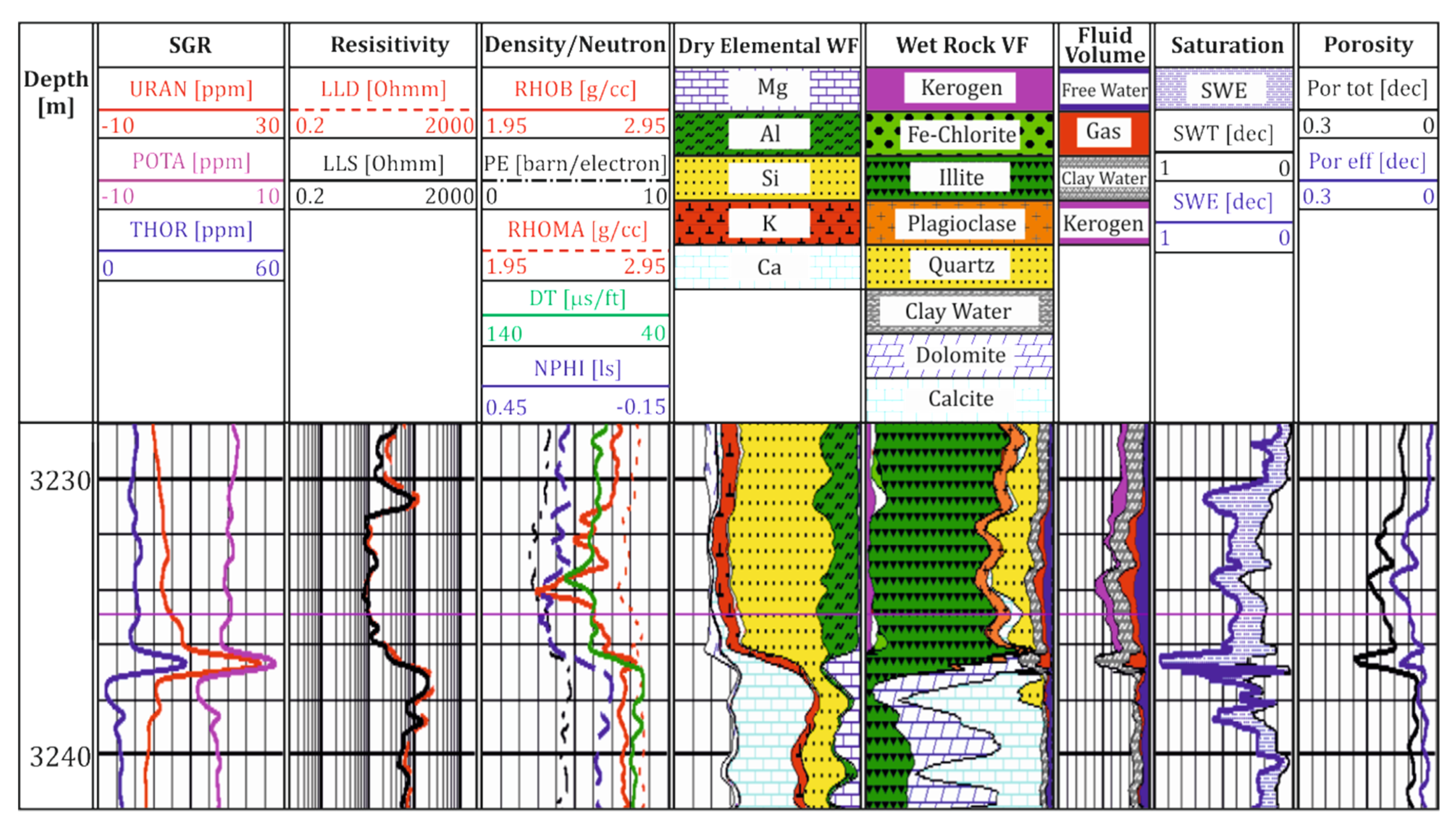
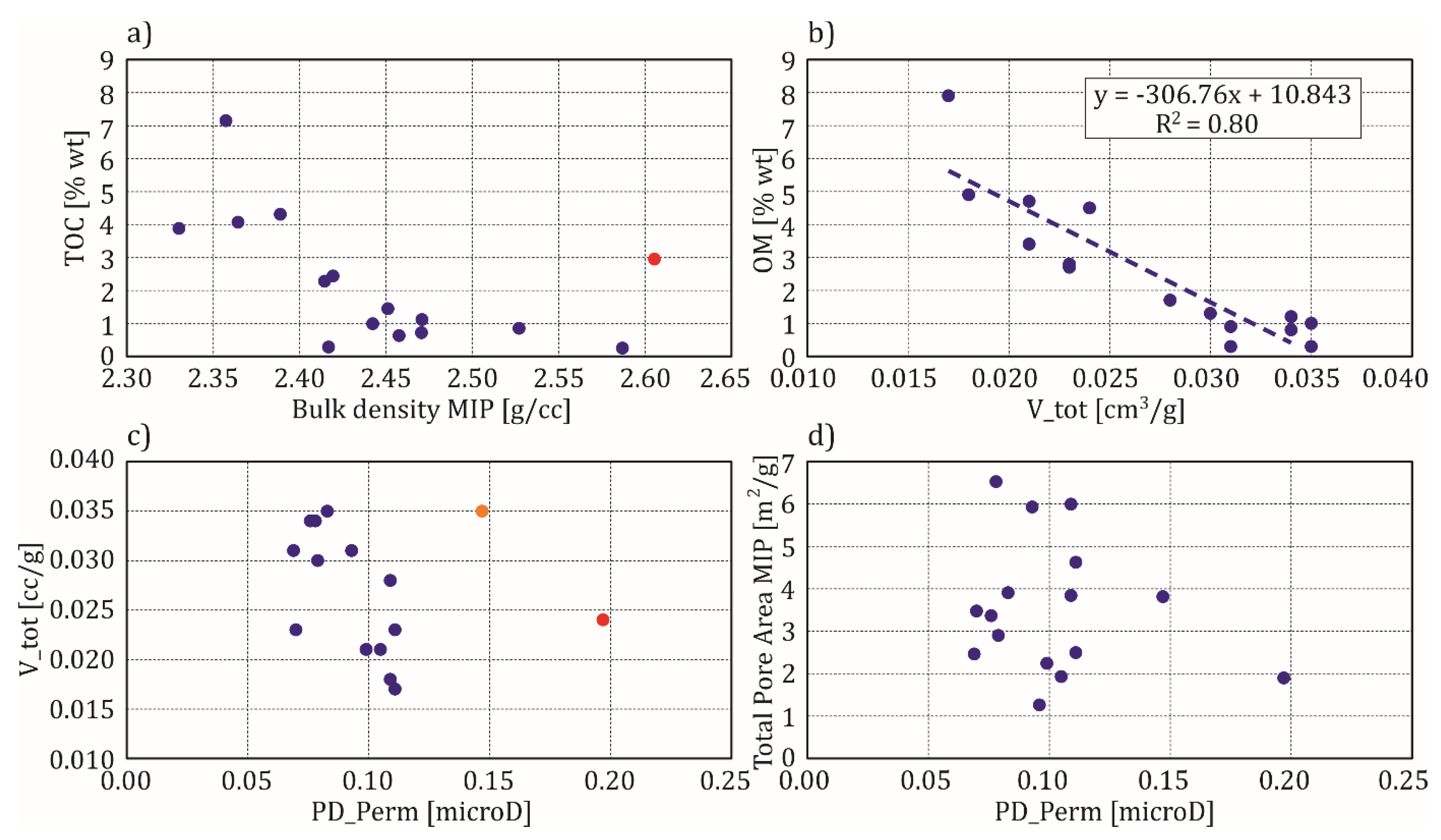
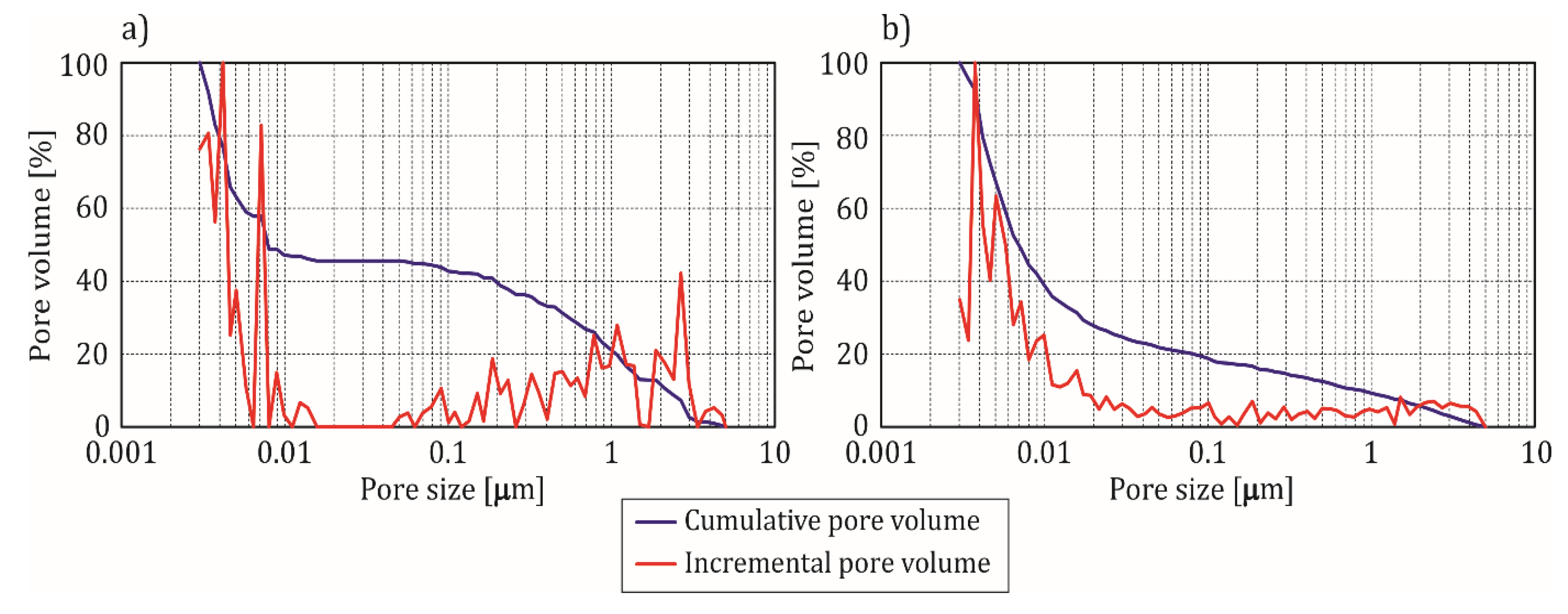
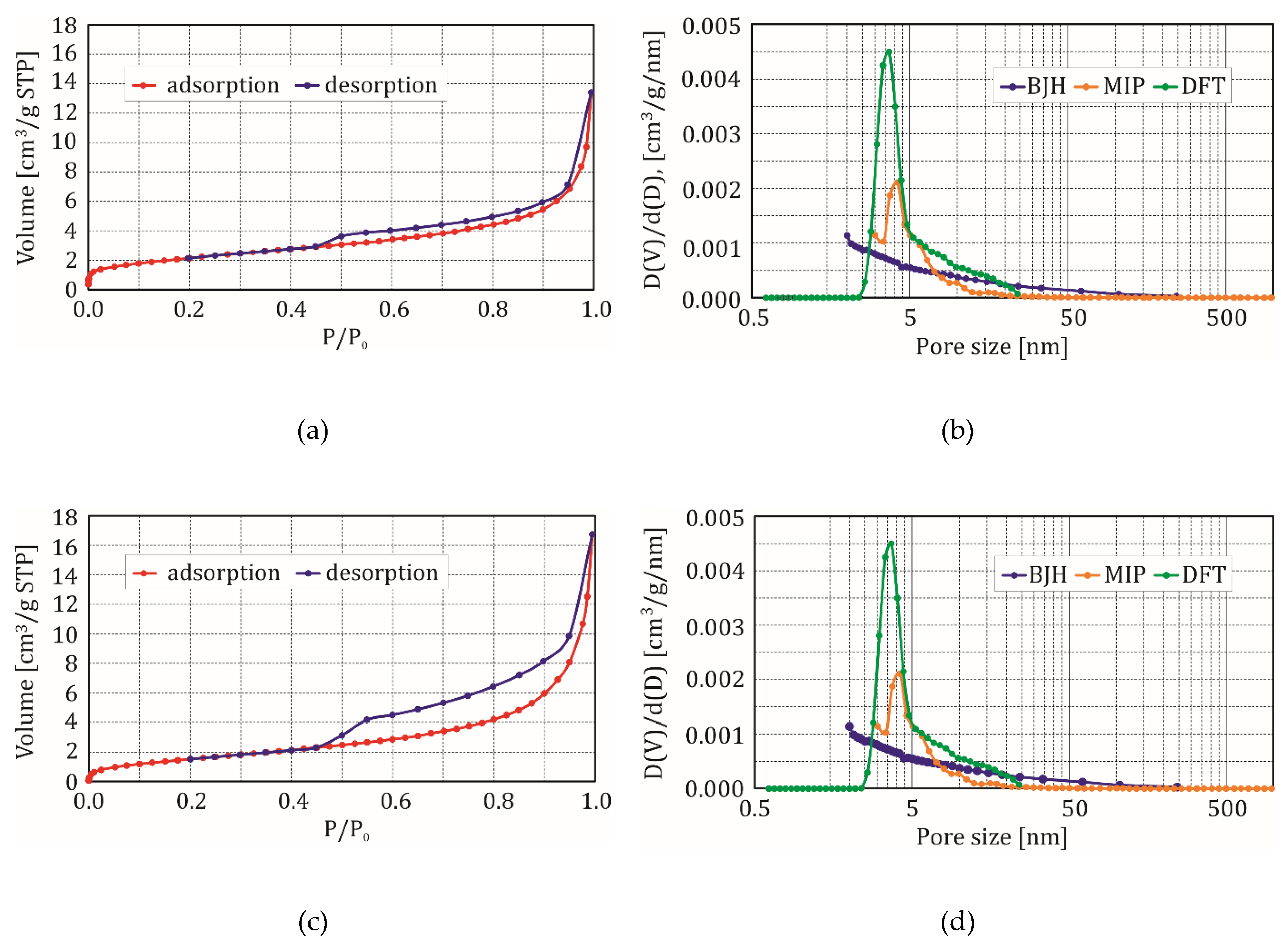
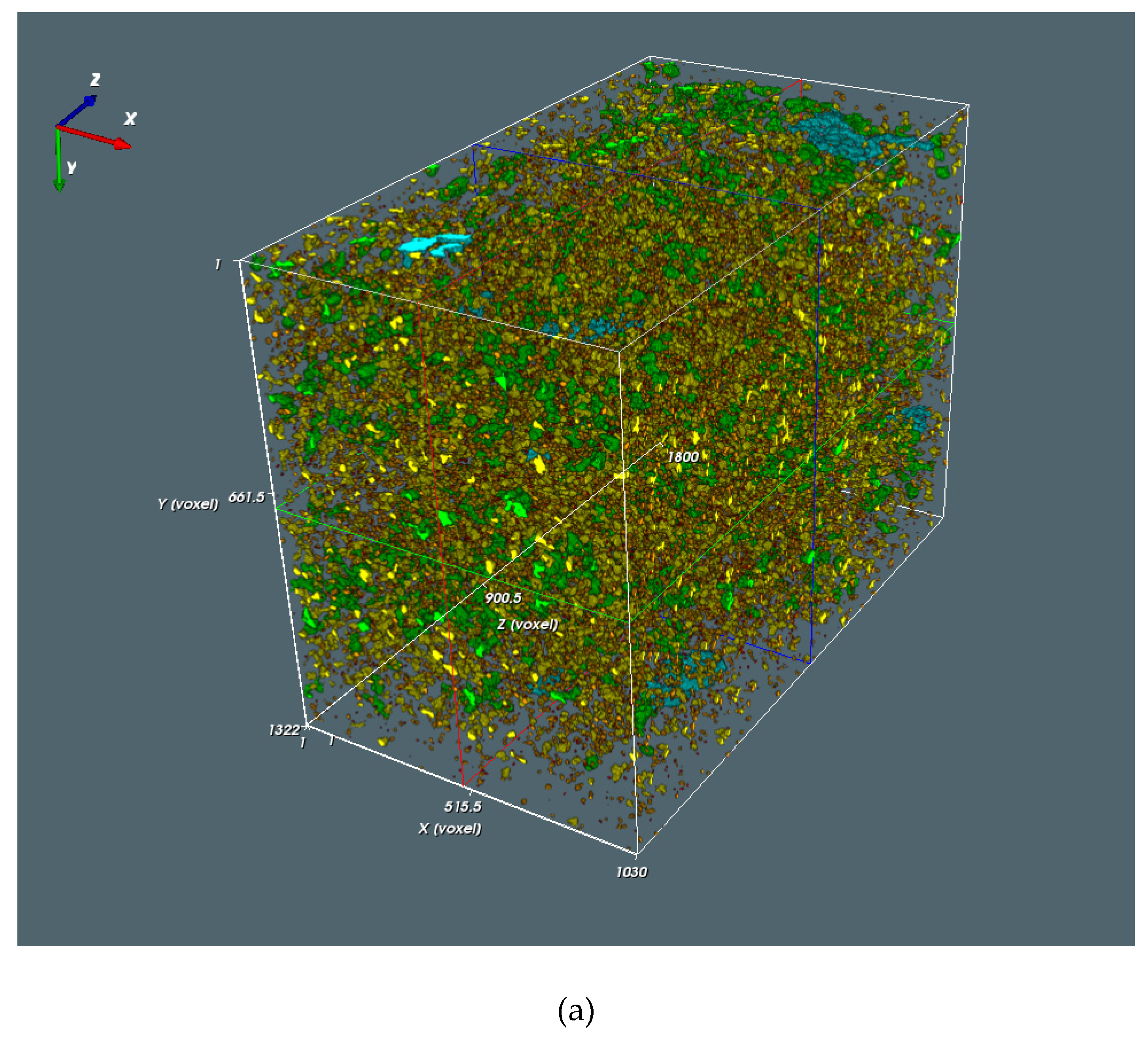
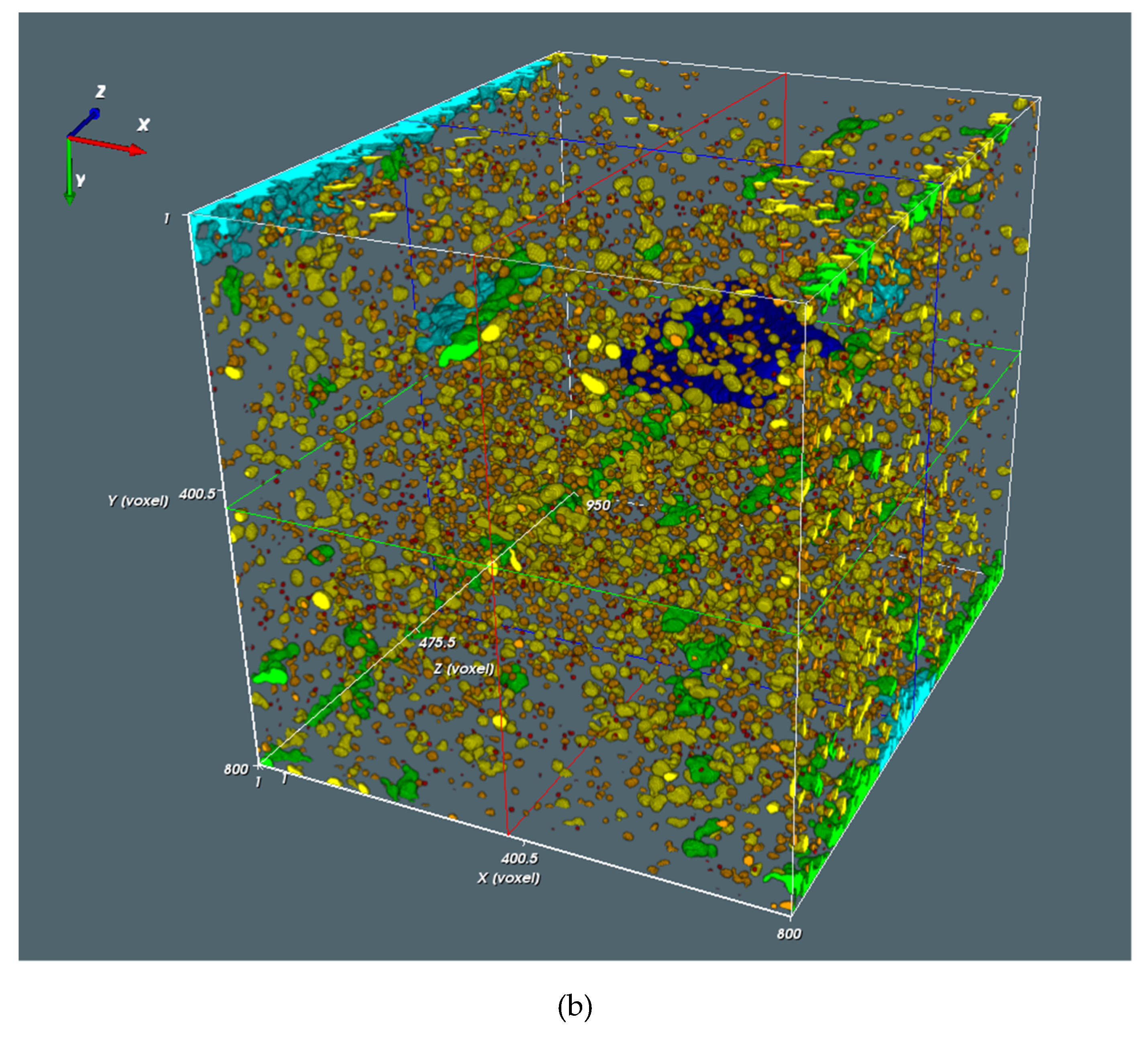
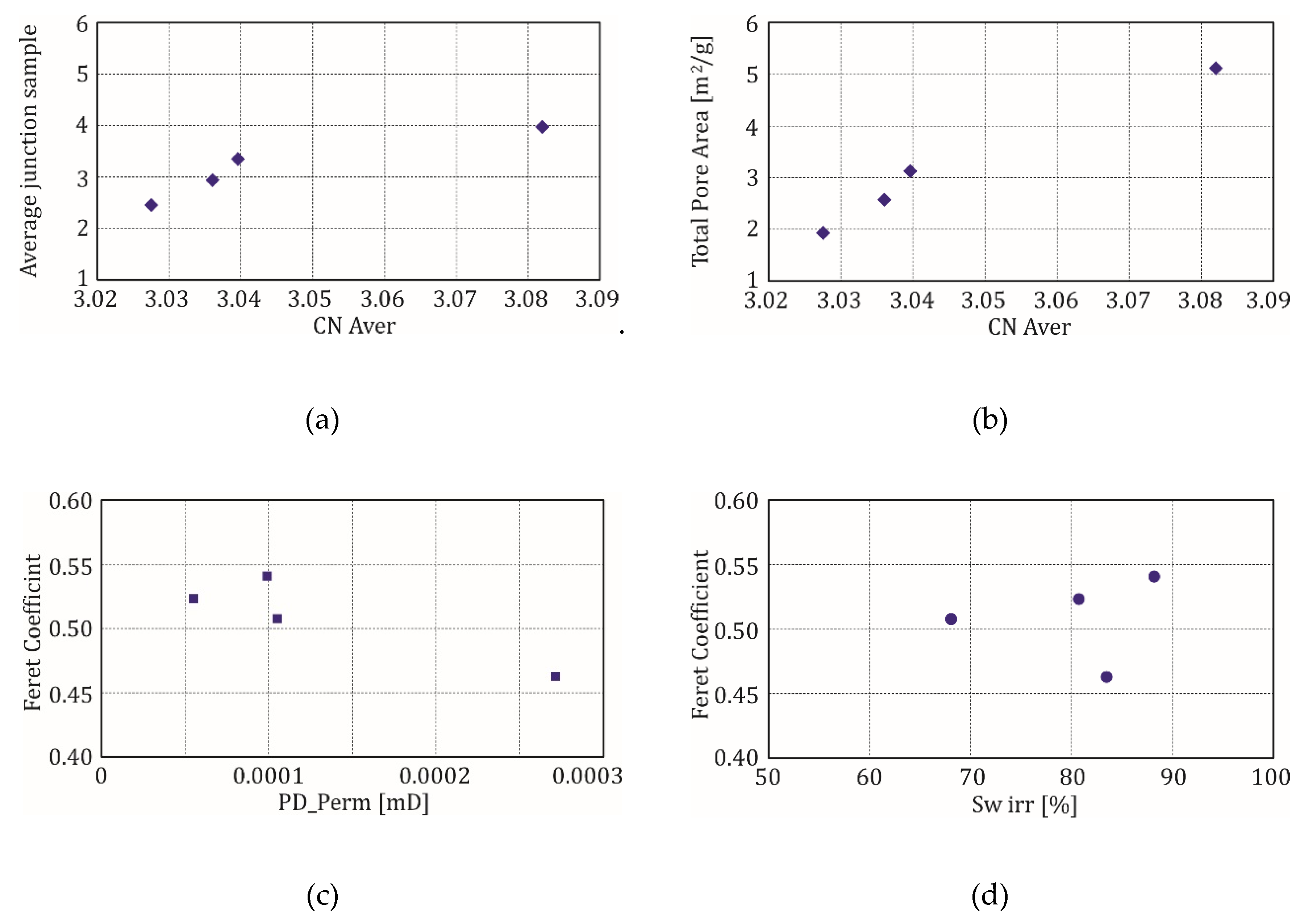

| Stratigraphy | Depth Interval (m) | ||
|---|---|---|---|
| Well-1 | Well-2 | Well-3 | |
| Silurian, Llandovery Pasłęk Formation (Pa Fm) | 3150.6–3212.0 | 2850.00– 2894.90 | 2803.1–2871.0 |
| Silurian, Llandovery Jantar Member (Ja Mb) in Pa Fm | 3198.1–3212.0 | 2895.00–2906.90 | 2871.1–2884.0 |
| Ordovician, Ashgillian Prabuty Formation (Pr Fm) | 3212.0–3217.5 | 2907.00–2914.90 | 2884.1–2892.0 |
| Ordovician, Caradocian, Llanvirnian Sasino Formation (Sa Fm) | 3217.6–3237.0 | 2915.00–2940.90 | 2892.1–2917.5 |
| Ordovician, Llanvirnian, Llandeilian Kopalino Formation (Ko Fm) | 3237.1–3249.0 | 2941.00–2958.00 | 2917.6–2935.5 |
| Sample | Depth (m) | Stratigraphy | TOC (Rock-Eval) (wt %) | Bulk Density (MIP) (g/cc) | Grain Density (HeP) (g/cc) | Porosity (MIP) (%) | Total Pore Area (MIP) (m2/g) | V-tot (cc/g) | OM (wt %) | Permeability (Pulse D) *(10−3) (mD) | Bulk Density (PD) (g/cc) | Permeability (Pressure D) *(10−3) (mD) |
|---|---|---|---|---|---|---|---|---|---|---|---|---|
| Standard Laboratory Measurements | Pressure Decay | |||||||||||
| Well-1(11) | 3216 | Sa Fm | 4.31 | 2.39 | 2.60 | 2.24 | 3.84 | 0.018 | 4.9 | 0.307 | 2.516 | 0.109 |
| Well-1(13) | 3221.5 | Sa Fm | 3.88 | 2.33 | 2.60 | 1.01 | 1.89 | 0.024 | 4.5 | 582.8 | 2.488 | 0.197 |
| Well-1(16) | 3228.5 | Sa Fm | 0.72 | 2.47 | 2.70 | 1.28 | 2.46 | 0.031 | 0.9 | 2.648 | 0.069 | |
| Well-1(25) | 3233 | Sa Fm | 2.28 | 2.41 | 2.64 | 1.68 | 3.48 | 0.023 | 2.7 | 2.609 | 0.070 | |
| Well-1(26) | 3234 | Sa Fm | 2.95 | 2.61 | 2.633 | 1.03 | 1.93 | 0.021 | 3.4 | 22.81 | 2.586 | 0.105 |
| Well-3(1) | 2870 | Pa Fm | 0.28 | 2.42 | 2.81 | 2.48 | 5.93 | 0.031 | 0.3 | 2.707 | 0.093 | |
| Well-3(2) | 2871 | Ja Mb | 7.15 | 2.36 | 2.54 | 1.10 | 2.49 | 0.017 | 7.9 | 2.440 | 0.111 | |
| Well-3(3) | 2872 | Ja Mb | 2.44 | 2.42 | 2.66 | 2.01 | 4.63 | 0.023 | 2.8 | 2.536 | 0.111 | |
| Well-3(4) | 2875 | Ja Mb | 4.07 | 2.36 | 2.61 | 1.35 | 2.24 | 0.021 | 4.7 | 2783 | 2.444 | 0.099 |
| Well-3(5) | 2878 | Ja Mb | 0.63 | 2.46 | 2.70 | 2.62 | 6.52 | 0.034 | 0.8 | 2.594 | 0.078 | |
| Well-3(6) | 2882 | Ja Mb | 1.12 | 2.47 | 2.70 | 1.48 | 2.90 | 0.03 | 1.3 | 2.590 | 0.079 | |
| Well-3(7) | 2885 | Pr Fm | 2.34 | 0.98 | 1.26 | 0.4 | 0.309 | 2.674 | 0.096 | |||
| Well-3(12) | 2910 | Sa Fm | 0.99 | 2.44 | 2.68 | 2.27 | 3.37 | 0.034 | 1.2 | 2.610 | 0.076 | |
| Well-3(16) | 2880 | Ja Mb | 1.45 | 2.45 | 2.70 | 2.47 | 5.99 | 0.028 | 1.7 | 2.583 | 0.109 | |
| Well-3(17) | 2887 | Pr Fm | 0.25 | 2.59 | 2.76 | 1.56 | 3.81 | 0.035 | 0.3 | 2.667 | 0.147 | |
| Well-3(18) | 2908 | Sa Fm | 0.85 | 2.53 | 2.72 | 1.89 | 3.91 | 0.035 | 1.0 | 2.622 | 0.083 | |
| Sample | Depth (m) | Stratigraphy | TOC (Rock-Eval) (wt %) | Bulk Density (MIP) (g/cc) | Bulk Density (PPD) (g/cc) | Porosity (MIP) (%) | Total Pore Area (MIP) (m2/g) | Sw Irr (NMR) (%) | Permeability (PPD) *(10−3) (mD) | CN Avr | Avr Junction Sample | Feret Coefficient |
|---|---|---|---|---|---|---|---|---|---|---|---|---|
| Standard Laboratory Measurements | Micro-CT Parameters | |||||||||||
| Well-1(26) | 3234.11 | Sa Fm | 2.95 | 2.61 | 2.59 | 1.03 | 1.93 | 68.10 | 0.105 | 3.028 | 2.451 | 0.508 |
| Well-2(1) | 2896.75 | Ja Mb | 7.4 | 2.39 | 2.50 | 2.39 | 5.12 | 80.75 | 0.055 | 3.082 | 3.973 | 0.523 |
| Well-2(4) | 2903.90 | Ja Mb | 1.79 | 2.53 | 2.59 | 1.47 | 2.58 | 88.21 | 0.099 | 3.036 | 2.936 | 0.541 |
| Well-2(7) | 2923.98 | Sa Fm | 3.5 | 2.42 | 2.46 | 1.74 | 3.13 | 83.51 | 0.271 | 3.040 | 3.348 | 0.463 |
| CT Analysis | Volume Class (voxels) | 1–99 | 100–999 | 1000–9999 | 10,000–99,999 | 100,000–999,999 | >1,000,000 | SUM |
|---|---|---|---|---|---|---|---|---|
| Well-1(26) | # | 15,314 | 21,563 | 8020 | 1025 | 16 | 0 | 45,938 |
| % | 33.33 | 46.94 | 17.46 | 2.23 | 0.04 | 0 | 100 | |
| Well-2(7) | # | 2211 | 3743 | 1440 | 73 | 4 | 1 | 7472 |
| % | 29.59 | 50.09 | 19.28 | 0.98 | 0.05 | 0.01 | 100 |
© 2020 by the authors. Licensee MDPI, Basel, Switzerland. This article is an open access article distributed under the terms and conditions of the Creative Commons Attribution (CC BY) license (http://creativecommons.org/licenses/by/4.0/).
Share and Cite
Krakowska-Madejska, P.I.; Jarzyna, J.A. Diverse Scale Data for Shale Gas Formation Description—Why Is Digital Shale Rock Model Construction Difficult? The Polish Silurian and Ordovician Rocks Case Study. Minerals 2020, 10, 108. https://doi.org/10.3390/min10020108
Krakowska-Madejska PI, Jarzyna JA. Diverse Scale Data for Shale Gas Formation Description—Why Is Digital Shale Rock Model Construction Difficult? The Polish Silurian and Ordovician Rocks Case Study. Minerals. 2020; 10(2):108. https://doi.org/10.3390/min10020108
Chicago/Turabian StyleKrakowska-Madejska, Paulina I., and Jadwiga A. Jarzyna. 2020. "Diverse Scale Data for Shale Gas Formation Description—Why Is Digital Shale Rock Model Construction Difficult? The Polish Silurian and Ordovician Rocks Case Study" Minerals 10, no. 2: 108. https://doi.org/10.3390/min10020108
APA StyleKrakowska-Madejska, P. I., & Jarzyna, J. A. (2020). Diverse Scale Data for Shale Gas Formation Description—Why Is Digital Shale Rock Model Construction Difficult? The Polish Silurian and Ordovician Rocks Case Study. Minerals, 10(2), 108. https://doi.org/10.3390/min10020108






